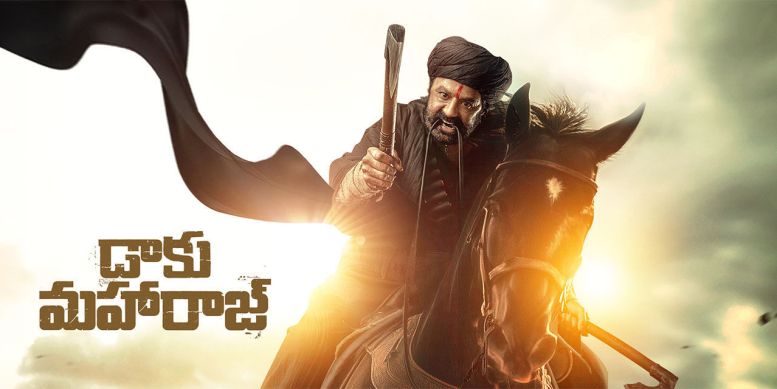“Nandamuri Balakrishna’s Daring Comeback: A Review of ‘Daaku Maharaaj’
The mighty Nandamuri Balakrishna is back, and this time, he’s trading in his iconic roles as a hero for a more daring, ruthless, and devilish persona. ‘Daaku Maharaaj’ has been generating immense buzz in the Telugu film industry, with fans eagerly waiting to witness the mass appeal of their beloved hero. But does this film live up to the hype? Our team at Gizmoposts24 dove into the world of ‘Daaku Maharaaj’ to bring you an honest review of this highly-anticipated movie.

Daaku Maharaaj: A Stylish Showcase for Balakrishna’s Mass Appeal
Balakrishna’s Mass Appeal Takes Center Stage

Daaku Maharaaj, directed by Bobby Kolli, is a quintessential Telugu mass entertainer that revolves around the larger-than-life persona of Nandamuri Balakrishna. The film revels in traditional tropes of the genre, catering directly to Balakrishna’s fervent fan base. The narrative revolves around Daaku Maharaaj (Balakrishna), a fearless and charismatic leader seeking to right wrongs in a corrupt system. This archetype, a powerful figure fighting against injustice, is a staple of Telugu cinema, and Balakrishna embodies it with his characteristic intensity and screen presence.
The film doesn’t shy away from the conventions of the mass entertainer. We see elaborate action sequences, larger-than-life villain portrayals, and a heavy dose of emotional melodrama, all elements designed to elicit cheers and applause from the audience. While this formulaic approach might not appeal to every viewer, it undeniably serves its purpose, delivering a satisfying experience for those who relish in this style of filmmaking.
Balakrishna’s performance is undoubtedly the heart and soul of Daaku Maharaaj. He effortlessly commands attention, his charisma radiating through every scene. Whether he’s delivering a fiery dialogue, engaging in a physical confrontation, or expressing raw emotion, Balakrishna inhabits the role with conviction, making Daaku Maharaaj a vehicle for his undeniable star power.
A Feast for the Senses: Technical Brilliance and Visual Spectacle
Beyond Balakrishna’s performance, Daaku Maharaaj impresses with its technical prowess. Cinematographer Vijay Kannan crafts a visually stunning world, capturing the grandeur of the narrative with meticulous detail. From the sweeping landscapes of the Thakur Palace to the gritty realism of the sandstorm sequence, Kannan’s lens brings a cinematic quality rarely seen in Telugu action films.
The production design is equally impressive, with lavish sets and attention to detail that create a sense of opulence and authenticity. The costumes, too, are carefully chosen, reflecting the characters’ status and personalities. This commitment to visual excellence elevates the film beyond the typical mass entertainer, transforming it into a feast for the senses.
Beyond the Fireworks: A Story That Could Have Been More
While the technical brilliance and Balakrishna’s performance are undeniable strengths, Daaku Maharaaj’s storyline falls into familiar territory. It adheres closely to the conventions of the revenge drama, offering a predictable narrative arc that lacks significant surprises. The first half, however, keeps the audience engaged with its well-paced build-up and captivating action sequences. The sandstorm episode, for instance, is a standout moment, showcasing both the visual flair and Balakrishna’s ability to command the screen with his raw intensity.
Unfortunately, the momentum falters in the second half, which succumbs to routine tropes and a predictable climax. The pacing drags in certain sections, and the emotional beats, while intended to be impactful, lack the depth to resonate fully. Had the narrative explored more nuanced themes or taken risks beyond the familiar revenge plot, Daaku Maharaaj could have been a truly memorable cinematic experience.
Supporting Performances: Charisma Meets Limited Scope
The supporting cast, while talented, is unfortunately relegated to relatively one-dimensional roles. Bobby Deol, as the primary antagonist, brings a menacing presence to the screen, particularly in his confrontations with Balakrishna. Urvashi Rautela and Shraddha Srinath add their own charm and capability, but their characters lack the depth and agency to make a lasting impact. Pragya Jaiswal, in a smaller role, complements Balakrishna’s on-screen charisma effectively.
The film’s structure primarily focuses on amplifying Balakrishna’s star power. While this is understandable given his dedicated fanbase, it unfortunately limits the opportunity for the supporting actors to demonstrate their full range and contribute meaningfully to the narrative.
Daaku Maharaaj: A Verdict for Mass Cinema Enthusiasts
Daaku Maharaaj is a visually stunning and action-packed film that caters to the tastes of Telugu mass cinema enthusiasts. Balakrishna delivers a powerhouse performance, surrounded by a technical team that elevates the film’s presentation to a grand scale. However, the predictable storyline and uneven pacing prevent it from reaching its full potential. While fans of Balakrishna and traditional Telugu action films will likely enjoy the film, those seeking a more nuanced or innovative narrative might find themselves underwhelmed.
Conclusion
“Daaku Maharaaj” undeniably delivers a spectacle, showcasing Balakrishna’s raw charisma and undeniable mass appeal. While the narrative might feel predictable at times, the film thrives on its larger-than-life action sequences, vibrant visuals, and the sheer energy Balakrishna brings to the screen. The movie’s success hinges on its ability to transport viewers into a world of stylized heroism, where morals are fluid and entertainment reigns supreme. This reinforces the enduring power of such masala narratives in Indian cinema, catering to a specific audience craving spectacle and unabashed heroism.







Add Comment